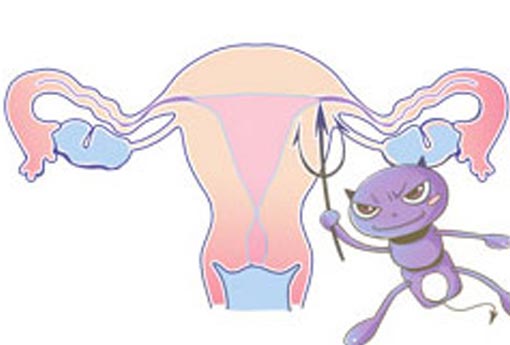Basic Information
Chinese name: vagina
Pronunciation: yīn dào
Foreign name: vagina, cun
Function: Sexual organs, reproductive organs
Category: Human Organs
Structure
The structure of the vagina is mainly narrow at the lower part, and the lower end opens into the vestibule of the vagina through the vaginal opening. In the virgin stage, there is a hymen attached around the vaginal opening, which can be annular, half-moon, umbrella or sieve. After the hymen is ruptured, a hymen scar is left around the vaginal opening.
The upper end of the vagina is wide and wraps around the cervix and vagina, forming an annular depression between the two, called the vaginal dome, which can be divided into anterior, posterior and two sides. The posterior part of the vaginal dome is the deepest, and is closely adjacent to the rectum-uterine depression, separated only by the vaginal wall and a layer of peritoneum. Clinically, it has great practical significance, such as the ability to drain the effusion in the depression through the posterior fornix.
Physiological anatomy
The vagina is a flexible tubular organ located between the bladder, urethra and rectum. It has a variety of physiological functions in the process of human reproduction. It is a channel connecting the uterus and the vulva. It is the only way to discharge menstrual blood and deliver babies. It is also an important sexual intercourse organ. The vaginal opening is located in the diamond-shaped space between the labia minora on both sides—the back of the vaginal vestibule. The shape and size of the vaginal opening vary greatly among individuals. If the vaginal opening is narrow, it often causes difficulty in sexual intercourse. There is also an annular mucosal fold called the hymen in the vaginal opening of the virgin. this membrane-like tissue contains connective tissue, blood vessels and nerve endings, which can partially seal the vagina. The inner edge of the hymen is sharp and complete, and the hymen of unmarried women is light red. The hymen is usually not completely sealed, and has a small hole in the middle for menstrual blood to flow out after puberty. The shape and size of the pores and the thickness of the membrane can vary from person to person. The hymen of unmarried women is generally half-moon-shaped or oval-shaped, and can also be sieve-shaped, radial-shaped, fish-mouth-shaped or other shapes.
They vary in size, some are so small that they cannot fit through one finger, and some are so large that they can fit two fingers. The hymen is generally about 2 mm thick, and it is mostly ruptured during the first sexual intercourse, but there are many exceptions. If the hymen is too narrow and thin, it can rupture during exercise, vibration, and placement of menstrual plugs. From the perspective of sex life, people are more concerned about the vagina, because after all, it is directly related to sex life. People jokingly call it a "hole" or a "bucket", but it is not actually a cave, but a closed space. It functions a bit like a balloon, in that the walls of the vagina are usually close to each other, but can be fully expanded when needed. The vagina is actually an elastic muscle organ, which can contract and relax. When it contracts, it can't even insert a little finger. When it relaxes, the penis can be inserted or twitched at will, and it can even accommodate the fetus and allow the fetus to pass through it. The tightness of the female vagina is very different. The vagina of unmarried women is relatively tight and the muscles are full of elasticity. After giving birth, the vaginal wall becomes loose and the vagina is relatively loose. Many people lack understanding of the systolic and diastolic potential of the vagina. Men, out of concern for couples, are afraid that penetration of the penis will cause damage to the woman's body, and women are also worried that sexual intercourse will harm their body.
Some people worry that the vagina is too narrow to limit the penetration of the penis. In fact, a real small vagina and a real small penis are also rare. The problem lies in the reaction state of the woman during insertion. As long as the woman is highly excited, no matter how big the penis is, it will not be a problem. The problem, on the contrary, is that even a small penis will suffer if the woman is not excited at all. Long-term abstinence or postmenopausal women's sexual response is slow when they resume sex, so don't rush into the woman before she is highly excited, otherwise it will only bring her pain instead of pleasure. When the obstetric injury causes excessive vaginal relaxation, it not only greatly reduces the sensitivity of women's external sensation and proprioception during sexual intercourse, but also affects the external sensation stimulation of the man, but it is not so serious. This depends on the pubococcygeus muscle exercise to restore the muscle's tone, elasticity and adjustment ability. In adult women, the anterior vaginal wall is shorter, about 7 to 9 cm, and the posterior wall is longer, about 9 to 12 cm. Usually, the front and back walls of the vagina are close to each other so that the cross section is "h" shaped.
The upper segment is bent downward and backward, close to the sacral concave, and its lower end is bent forward, making the sagittal plane of the vagina an "s" shape. The upper end of the vagina is wider and surrounds the cervix. The annular space between the cervix and the vaginal wall, called the vaginal fornix, is divided into four parts: anterior, posterior, and left and right according to its location. The posterior fornix as the semen reservoir is particularly deep and wide. In the lithotomy position of the bladder, the posterior fornix of the vagina is the lowest part of the vagina. This anatomical relationship is conducive to the swimming of sperm from the vagina to the cervix, because the external os of the cervix is in the normal position. the posterior fornix of the vagina. The posterior fornix is the most dilatable part of the vagina, providing the necessary space for an erect penis while preventing excessive displacement of the cervix and possible dyspareunia.
In addition to vaginal epithelium and muscle, the vaginal wall also has a fibrous tissue adventitia. The vaginal epithelium is pink with stratified squamous epithelium but no keratinized layer. The epithelium of the vaginal wall has many folds and a rhombus-shaped palisade of muscle layers that are fully stretched during sexual intercourse and childbirth. During the normal menstrual cycle, the morphology of the epithelial cells exfoliated from the vaginal epithelium changes with the changes of ovarian endocrine. Therefore, the pathological examination of the exfoliated vaginal epithelium can preliminarily determine the endocrine function of the ovary.
Another important physiological feature of the vagina is that it has abundant muscles around it, called the pubococcygeus muscle. During sexual twitching, its slight contraction causes the penis to feel the "tightening" feeling, which will be felt during orgasm. Strong and rhythmic contractions, the grip on the man's penis is significantly enhanced. Some women's pubococcygeus muscles are weak and inflexible, especially after giving birth, making it difficult for men to experience the aforementioned gripping sensation during orgasm. The vagina itself has no secretory glands. Its normal secretions are composed of a small amount of exudate infiltrated by the rich vascular network around the epithelium, mixed with exfoliated epithelium and cervical mucus. Normally, the amount is not much, and it is protein-like or milky and moisturizing. vaginal.
After puberty, due to the stimulation of ovarian endocrine, the vaginal epithelial cells are rich in animal starch, which becomes starch after being decomposed by vaginal bacteria, so that the vaginal secretions are weakly acidic (pH about 4.5), which can prevent pathogenic bacteria from multiplying in the vagina. , the so-called self-purification of the vagina. The vagina of normal women is slightly moist and exudes a natural smell. If there is an abnormal smell, it is likely that it has not been cleaned for a long time or has inflammation. As long as you don't suffer from vaginal disease and can wash your genitals regularly, you don't have to be ashamed of the peculiar smell of your vagina, and there is no need to over-wash or use certain cosmetics or deodorants that are detrimental to your health.
The female urethra located above the vagina is very short, about 2.5-5 cm in length, 3.5 cm in average, about 0.8 cm in diameter, and 1-1.3 cm in expansion. Because the female urethra is short and straight, it is more prone to ascending infection. Due to lack of basic sexual knowledge, or because the hymen is too thick to prevent insertion, or because the woman does not have a vagina, they mistake the urethra for a vagina, and have sexual intercourse in the urethra for a long time, until the infertility prescription comes to diagnosis and treatment for many years. Surprisingly, this action did not pose a great threat to the urethral sphincter, which expands sufficiently when the penis enters the urethra and returns to its original shape after withdrawal, and it caused neither incontinence nor urinary tract infection .
Anatomical Division
The vagina is divided into four parts: anterior, posterior, left and right according to its position. The posterior fornix is the deepest, and it is closely adjacent to the rectum-uterine depression, which is the lowest in the pelvic cavity. Clinically, it can be punctured or drained.
In-depth analysis
Vaginal size: The question of whether a woman's vagina can match a man's. It is also the concern of many unmarried women. Usually, the depth of a woman's vagina is 7-12cm, and the width can accommodate two fingers. The vaginal wall has many horizontal wrinkles, which have greater flexibility and elasticity. When aroused, the depth of the vagina increases by one-third, and the width also increases, so there is generally no organ mismatch. We can often see tall husbands have a petite wife, and their sex lives are just as harmonious; many people of different races in the world can also marry and have children; women can also pass through the head of a fetus up to 10cm in diameter during childbirth Vagina, these can make us imagine how accommodating women's vaginas are, so your worries in this regard are completely unnecessary.
The time to stimulate the vagina: an average of only 30 seconds, just one deep kiss with a woman, the shape of the vagina is changing dramatically, and it is enough to put the woman into a state of combat readiness.
Vaginal angle: When a woman is lying down, the horizontal plane of the vagina and the bed is generally at a downward angle of 15 degrees, but it varies from person to person, so you must feel it clearly before deciding how to enter.
Vaginal temperature: The average is about 37 to 37.8 degrees Celsius; but when excited and congested, the temperature in the vagina can rise sharply to 38.5 degrees Celsius, which will accelerate the blood flow and make you excited.
Physiological function
The vagina is a very important conduit that connects the female internal and external genitalia. It is the female sexual organ and the channel for the discharge of menstrual blood and the delivery of the fetus. The upper end of the vagina is connected to the uterus, and its lower end is the vaginal opening. The front of the vagina is adjacent to the bladder and urethra, and the back is connected to the rectum and perineum. Because there is a bladder in front of the vagina and a rectum in the back, if it takes too long to give birth to a child, the head of the fetus presses against the vaginal wall for too long, which can lead to the necrosis of the vaginal wall due to hypoxia and ischemia, resulting in serious leakage of urine and feces. . Therefore, it is not advisable to prolong the labor process during labor.
Physiological functions of the vagina
① The channel that transports menstrual blood from the uterus to the outside of the body.
② An important place for women to have sex. The anterior wall of the lower vaginal segment is particularly sensitive to sexual activity.
③ Under normal circumstances, the vagina is the channel through which the fetus is delivered from the mother.
④ The vagina is the window for examining the female internal genitalia.
Physiological characteristics
①The potential for stretching and adjustment of the female vagina is sometimes quite amazing.
② Each segment of the vagina responds differently to sexual stimulation. For example, 1/3 of the outer vaginal segment is differentiated from ectoderm and is rich in nerve fibers, so the nerve endings that respond to touch are only concentrated near the vaginal opening. The inner 2/3 of the vagina is from the mesoderm and has no nerve endings, so the outer 1/3 of the vagina is more sexually sensitive than the inner 2/3. As far as the penis is concerned, although the size of the penis varies greatly during relaxation, the difference after erection decreases. Generally speaking, the depth of the outer vaginal segment can be greatly exceeded after erection. Therefore, the determinant of female sexual satisfaction is by no means the penis. size thickness.
③ Another important physiological feature of the vagina is that it has abundant muscles around it, called the pubococcygeus muscle.
④ The vagina itself has no secretory glands.








